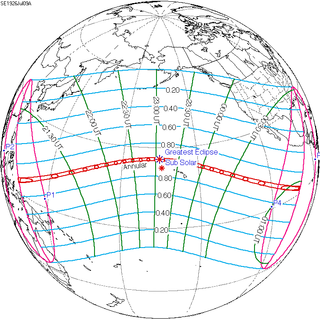| Solar eclipse of July 9, 1926 | |
|---|---|
| Type of eclipse | |
| Nature | Annular |
| Gamma | 0.0538 |
| Magnitude | 0.968 |
| Maximum eclipse | |
| Duration | 231 s (3 min 51 s) |
| Coordinates | 25°36′N 165°06′W / 25.6°N 165.1°W |
| Max. width of band | 115 km (71 mi) |
| Times (UTC) | |
| Greatest eclipse | 23:06:02 |
| References | |
| Saros | 135 (34 of 71) |
| Catalog # (SE5000) | 9342 |
An annular solar eclipse occurred at the Moon's ascending node of orbit between Friday, July 9 and Saturday, July 10, 1926,[1] with a magnitude of 0.968. A solar eclipse occurs when the Moon passes between Earth and the Sun, thereby totally or partly obscuring the image of the Sun for a viewer on Earth. An annular solar eclipse occurs when the Moon's apparent diameter is smaller than the Sun's, blocking most of the Sun's light and causing the Sun to look like an annulus (ring). An annular eclipse appears as a partial eclipse over a region of the Earth thousands of kilometres wide. Occurring about 4.3 days before apogee (on July 14, 1926, at 5:50 UTC), the Moon's apparent diameter was smaller.[2]
Annularity was visible from the islands of Pulo Anna and Merir in Japan's South Seas Mandate (now in Palau) and Wake Island on July 10 (Saturday), and Midway Atoll on July 9 (Friday). A partial eclipse was visible for parts of Northeast Asia, northern Oceania, Hawaii, southern North America, and Central America.
- ^ "July 9–10, 1926 Annular Solar Eclipse". timeanddate. Retrieved 3 August 2024.
- ^ "Moon Distances for London, United Kingdom, England". timeanddate. Retrieved 3 August 2024.
